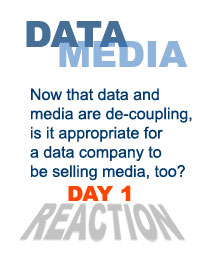Each day this week, AdExchanger.com will publish the thoughts of executives representing a cross-section of the digital advertising ecosystem in response to the following question:
“Now that data and media are de-coupling, is it appropriate for a data company be selling media, too?” In other words, is there a conflict of interest?
Click “read more” to read the participant’s answer.
Josh McFarland, CEO, TellApart: “It’s not a question of whether it’s appropriate; it’s imperative.” Read more.
Jerry Neumann, angel investor: “The whole online display advertising business has always been two steps forward and then become an ad network. The ad network business model is like a black hole.” Read more.
Alan Pearlstein, CEO, Cross Pixel Media: “Data buying also adds another level of complexity to a process that is already difficult to manage.” Read more.
Ken Treske, COO/CMO, Dotomi: “- it’s logical to decouple data from media since no single media outlet can represent that consistency since no single media company can provide complete reach.” Read more.
Josh McFarland, CEO, TellApart
It’s not a question of whether it’s appropriate; it’s imperative.
Decoupling data from media makes for a nice soundbite but is an operational nightmare. Pursuing the vision of portable, inventory-independent data has resulted in massive cookie duplication and high loss rates between first party data owner, second party data exchange and third party ad inventory provider. As a result, it’s hard for buyers to know what they’re actually getting (unique users, matched users, frequency and volume) regardless of whether the data’s source is transparent. Therefore, the re-coupling of data and inventory was inevitable. Further, only the careful curation of data, media and creative in combination can lift response rates enough to justify paying for data separately. So yes – if the “data layer” is to survive as a concept, it is appropriate for those vendors to take more control of the associated inventory.
Jerry Neumann, angel investor
Is bundling media and data okay? Is that a rhetorical question? Of course it’s okay, it’s called being an ad network.
The whole online display advertising business has always been two steps forward and then become an ad network. The ad network business model is like a black hole. Companies circle around it, feeling its pull. Then they give in, cross the event horizon and become featureless and undifferentiated. Another generation of innovation wasted.
Think about Tacoda, the prototypical data company. They would be cutting edge even today. Except that they were absorbed into the rest of the Ad.com ad network and ceased to have an independent existence. All that promise to create efficiency for marketers and publishers gone. Tacoda had data, but instead of selling data they sold targeted media. They were an ad network. Why?
Tacoda didn’t believe the agencies were sophisticated enough to use their data effectively. And, even if their data could turn a $1 CPM piece of inventory into something that performed like a $5 CPM piece of inventory, they didn’t believe that they would ever get paid anywhere near a $4 CPM for the data. I think they were right, because the only people who could use Tacoda’s data to turn a $1 CPM into a $5 CPM were inside of Tacoda. So Tacoda became an ad network and Tacoda is no more.
“So what?” you say “Tacoda sold for a boatload of money.” True. But it has left the rest of us reinventing the wheel, again. John Wanamaker’s notorious quip–“half the money I spend on advertising is wasted, I just didn’t know which half”–is still more or less true today, a century after he said it. That’s one hundred years with no noticeable efficiency improvements. Can any other industry boast such a horrendous record of stagnation?
In a lead generation company I once visited, all the computer monitors faced the back of the room, where the proprietor sat. He wanted to be able to see what everyone was doing, he wanted to know who was chatting to whom. He was pulling a half million dollars of profit out of his ten person shop every year, due to the knowledge he had in his head. But he knew that if any one person in the room figured out how to work the whole process, they could leave and make that money themselves. He knew this because that is what he had done.
This kind of thinking permeates the marketing world to one degree or another. Ad networks rely on opacity and obfuscation. Letting anyone else know how they make money would mean they won’t make money any more. But creation of knowledge is an open, group endeavour. A huge amount of resources and time are wasted every year pursuing ideas that some company has already proved fruitless because no one outside of that company knows they are fruitless. Those resources would be better used extending avenues of inquiry that are working, but that these avenues are working is also a closely protected secret.
I don’t know how to solve this. Nor, I suppose, does anyone else. It is the same problem, in micro-miniature, that plagued Europe from the fall of the Roman Empire until the Rennaissance: why would anyone invest in creating and disseminating common knowledge when they reap only a small part of the total benefit? Institutions are important, and certainly we need more of these. We need books, university courses, industry associations and summer internships focussed solely on the quantitative part of marketing. We need to better train our customers so they are not overwhelmed with the complexity of what our companies do. We need to share more information amongst ourselves about what is working and how well. We need fewer trade conferences and more colloquia.
But we also need a bit more idealism. We need to be trying to make the world a better place. We need to move beyond our defensive posture of being a necessary evil to the actual fact of being an indispensable part of the modern economy. If what we’re doing is less about convincing people to buy things and more about helping people navigate a complicated world, then innovation will emerge from all corners.
Becoming an ad network may be inevitable for many of today’s companies. But it means our segment of the industry gets absorbed into the rest of it and most of what we’ve invented disappears. I would never tell any of the companies I’ve invested in or work with to forgo viability for a principle, but I think we should all be urgently asking each other “how can we make this round of innovation a base on which to build further innovation?”
Alan Pearlstein, CEO, Cross Pixel Media
I think it is appropriate and sometimes necessary. The exciting part about the decoupling of media and data is that it unlocks the value of each component of an individual impression. Since both media and data have a separate value, a seller has to make a fair market offer for the data and the media. A buyer can make an intelligent decision about each and decide whether to buy them both from one supplier or separate suppliers.
Some data providers have made a business decision to build a wall around their data and control access to the data. In these cases, the buyer has no choice but to buy a package of media and data. I believe this the right strategy for owners of high value, unique, data – they need to protect the value of their asset by controlling access. Over time, they should also have a better understanding about which media to buy against their data,providing even greater value than a 3rd party that only sells media, but doesn’t have a deep understanding of the data. For example, I believe Acerno has a better understanding about which media to match with their data then a separate media buyer would if Acerno made the data available to them. In my opinion Acerno, is executing the correct strategy by selling the media with their data, and advertisers are probably benefiting from this approach.
Data buying also adds another level of complexity to a process that is already difficult to manage. More variables leads to more decisions and buyers need help in recoupling media and data. It’s great that we can decouple data and media to improve the performance of each campaign, but the process of recoupling the media with the data is not easy and service providers are needed to help the buyers. For all of the progress the large agencies are making in setting up their own trading desks to marry data and media, the vast majority of the advertisers I meet have no idea how to buy data driven display advertising. Most of these advertisers want to buy the data and media in one place, at least at this point in time.
Ken Treske, COO/CMO, Dotomi
Marketers must have a standard approach to their use of data in order to gain scale in their campaigns. Because of this, it’s logical to decouple data from media since no single media outlet can represent that consistency since no single media company can provide complete reach. That said, media can still play an important role in supporting data driven campaigns. Primarily, this has to do with supporting the types of integrations and business relationships that allow them to get their fair share of data-driven campaigns and therefore, create new selling opportunities at typically higher rates. It’s only through these mutually beneficial relationships that media can increase their market share from this type of business. And, if done right with the right partners, media should find that the revenues will flow more quickly and with less selling and operational effort.
At Dotomi, we believe that it’s important for media to choose their partners wisely so they can make the most of their inventory. Media should consider criteria such as the quality of the partners’ clients, their ability to scale, whether or not their technology is tested and whether or not they have an ongoing business “annuity” or an episodic one, when selecting service providers to partner with. As an example, Dotomi can bring higher rates than standard Run of Network buys and can sustain those buys for extended periods. This can increase revenues and effective CPM’s and can certainly increase margins since the cost of selling and support can be dramatically reduced.
Read: Day 1, Day 2, Day 3, Day 4














